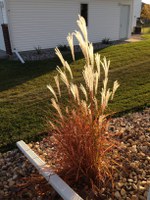Dakota Gardener: Putting the garden to bed
(Click an image below to view a high-resolution image that can be downloaded)
By Esther E. McGinnis, horticulturist
NDSU Extension
As a North Dakotan, I appreciate the end of the gardening season. By fall, I am weary of weeding gardens, watering container plantings and mowing the lawn.
Having just visited Georgia, I was reminded that southern gardeners don’t get the reprieve that we do. We have the luxury of taking an extended break from garden and lawn chores. By spring, our enthusiasm is renewed and we can’t wait to dig in the soil.
With our autumn freezes, it is time to put the garden and lawn to bed for the long winter. Here are some tips to make gardening in spring easier.
Pull up spent vegetable plants. Plants that were healthy during summer can be composted. Plants showing signs of disease should not be integrated into the compost pile because fungal spores can persist. For example, tomato plants showing leaf spots or cucumbers with powdery mildew should be disposed to minimize future disease issues.
Leave perennial flower stems in the garden until spring. We used to cut these plants back in the fall but leaving them over the winter may have numerous advantages. Seedheads from conflowers, sedum, bee balm and asters provide food for the birds. Many wild bees lay their eggs in the stems of perennials. Preserving the stems until spring allows native pollinators a chance to hatch.
Tall ornamental grasses should not be trimmed in the fall. The attractive seedheads provide winter interest in the garden. Furthermore, studies have shown that their stems will trap snow which helps insulate the plants and ensures their survival over the winter.
If tree leaves are not too thick, they can be mowed into the lawn. Tree leaves contain nitrogen that can be beneficial for the lawn.
Thick layers of leaves should not be allowed to persist on the lawn. The leaves will mat down the grass and make the lawn more susceptible to snow mold and to voles. In that case, rake up the valuable leaves. The leaves can be composted. Alternatively, the leaves can be shredded in a wood chipper and used as mulch to protect perennials and roses that are borderline hardy for the region. The mulch can be applied after a hard freeze.
What about pruning trees and shrubs? This is one task where it is better to be lazy in the fall. Postpone pruning trees and shrubs until March or early April before budbreak. Fall pruning can sometimes result in desiccation of the pruning wounds over the winter.
If it has been a number of years since your last soil test, consider sending a sample from your garden to a local soil testing lab. We are seeing more and more vegetable gardens that have an excess of phosphorus which can lead to stunting of vegetable plants and a general failure to thrive.
Finally, make a list of your favorite vegetables or annual flowers that you tried this year. Trust me, you won’t remember the names by next spring.
Happy fall!
NDSU Agriculture Communication – Oct. 11, 2022
Source: Esther McGinnis, 701-231-7971, esther.mcginnis@ndsu.edu
Editor: Kelli Anderson, 701-231-6136, kelli.c.anderson@ndsu.edu




